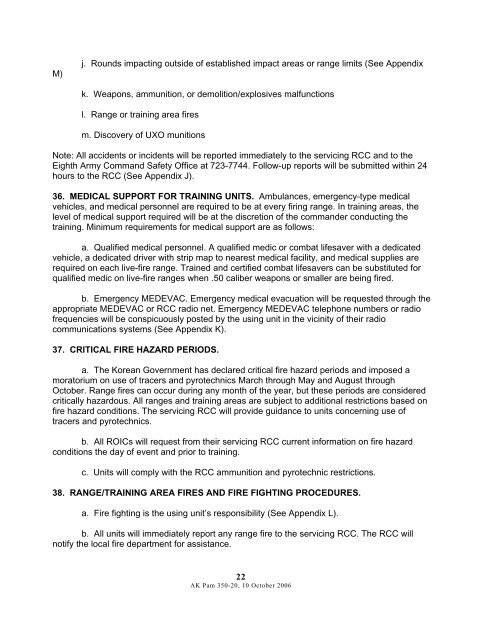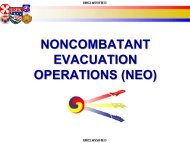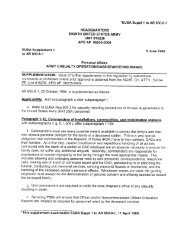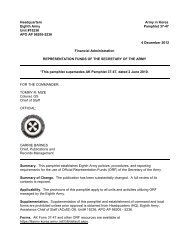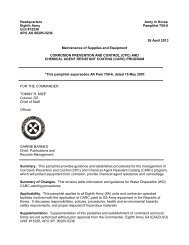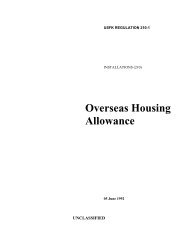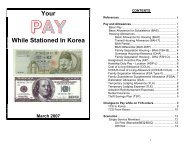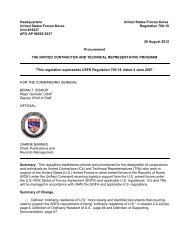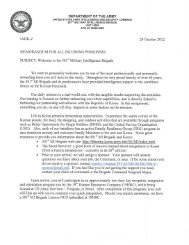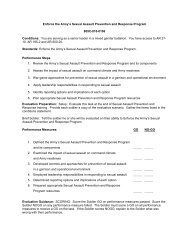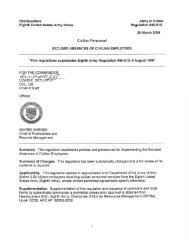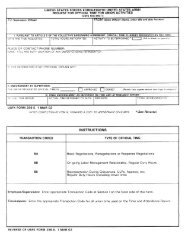AK Pamphlet 350-20 Eighth Army Range and Training Area
AK Pamphlet 350-20 Eighth Army Range and Training Area
AK Pamphlet 350-20 Eighth Army Range and Training Area
You also want an ePaper? Increase the reach of your titles
YUMPU automatically turns print PDFs into web optimized ePapers that Google loves.
M)<br />
j. Rounds impacting outside of established impact areas or range limits (See Appendix<br />
k. Weapons, ammunition, or demolition/explosives malfunctions<br />
l. <strong>Range</strong> or training area fires<br />
m. Discovery of UXO munitions<br />
Note: All accidents or incidents will be reported immediately to the servicing RCC <strong>and</strong> to the<br />
<strong>Eighth</strong> <strong>Army</strong> Comm<strong>and</strong> Safety Office at 723-7744. Follow-up reports will be submitted within 24<br />
hours to the RCC (See Appendix J).<br />
36. MEDICAL SUPPORT FOR TRAINING UNITS. Ambulances, emergency-type medical<br />
vehicles, <strong>and</strong> medical personnel are required to be at every firing range. In training areas, the<br />
level of medical support required will be at the discretion of the comm<strong>and</strong>er conducting the<br />
training. Minimum requirements for medical support are as follows:<br />
a. Qualified medical personnel. A qualified medic or combat lifesaver with a dedicated<br />
vehicle, a dedicated driver with strip map to nearest medical facility, <strong>and</strong> medical supplies are<br />
required on each live-fire range. Trained <strong>and</strong> certified combat lifesavers can be substituted for<br />
qualified medic on live-fire ranges when .50 caliber weapons or smaller are being fired.<br />
b. Emergency MEDEVAC. Emergency medical evacuation will be requested through the<br />
appropriate MEDEVAC or RCC radio net. Emergency MEDEVAC telephone numbers or radio<br />
frequencies will be conspicuously posted by the using unit in the vicinity of their radio<br />
communications systems (See Appendix K).<br />
37. CRITICAL FIRE HAZARD PERIODS.<br />
a. The Korean Government has declared critical fire hazard periods <strong>and</strong> imposed a<br />
moratorium on use of tracers <strong>and</strong> pyrotechnics March through May <strong>and</strong> August through<br />
October. <strong>Range</strong> fires can occur during any month of the year, but these periods are considered<br />
critically hazardous. All ranges <strong>and</strong> training areas are subject to additional restrictions based on<br />
fire hazard conditions. The servicing RCC will provide guidance to units concerning use of<br />
tracers <strong>and</strong> pyrotechnics.<br />
b. All ROICs will request from their servicing RCC current information on fire hazard<br />
conditions the day of event <strong>and</strong> prior to training.<br />
c. Units will comply with the RCC ammunition <strong>and</strong> pyrotechnic restrictions.<br />
38. RANGE/TRAINING AREA FIRES AND FIRE FIGHTING PROCEDURES.<br />
a. Fire fighting is the using unit’s responsibility (See Appendix L).<br />
b. All units will immediately report any range fire to the servicing RCC. The RCC will<br />
notify the local fire department for assistance.<br />
22<br />
<strong>AK</strong> Pam <strong>350</strong>-<strong>20</strong>, 10 October <strong>20</strong>06


